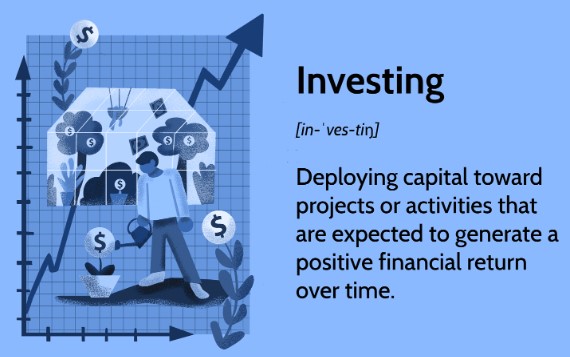In a world driven by financial aspirations, understanding the meaning of investment is paramount. Whether you’re a novice or an experienced investor, mastering the intricacies of investing can pave the way for a prosperous future. In this guide, we delve deep into the diverse facets of investment, providing insights, strategies, and expert advice to empower you on your financial journey.
What is Investment?

Investment is not merely about allocating funds; it’s about sowing seeds for future growth and prosperity. At its core, investment involves deploying capital with the expectation of generating returns or income over time. Whether it’s stocks, bonds, real estate, or alternative assets, the essence of investment lies in strategic allocation and prudent decision-making.
Types of Investment
Understanding the various types of investment is crucial for crafting a diversified portfolio that aligns with your financial goals. From traditional meaning of investment like stocks and bonds to alternative avenues such as cryptocurrencies and commodities, exploring diverse investment vehicles can enhance risk-adjusted returns and foster long-term wealth accumulation.
The Importance of Investment
Investing transcends mere wealth accumulation; it’s a cornerstone of financial independence and security. By embracing the importance of investment, individuals can safeguard against inflation, build assets, and create passive income streams. Moreover, prudent investment practices lay the groundwork for achieving life goals, be it buying a home, funding education, or retiring comfortably.
Benefits of Investing
Unlocking the myriad benefits of investing empowers individuals to harness the power of compounding and capitalize on market opportunities. From wealth preservation and capital appreciation to tax advantages and portfolio diversification, investing offers a plethora of advantages that amplify financial well-being and resilience.
Understanding Risk and Return
The nexus between risk and return lies at the heart of meaning of investment dynamics. While higher returns often entail greater risk, understanding how to balance risk and return is pivotal for optimizing investment outcomes. By embracing risk and return, investors can tailor their strategies to align with their risk tolerance, time horizon, and financial objectives.
Risk Management Strategies
Mitigating risk is an integral aspect of meaning of investment management. Implementing robust risk management strategies, such as asset allocation, diversification, and periodic rebalancing, can safeguard portfolios against market volatility and unforeseen events. Moreover, adopting a disciplined approach to risk management fosters resilience and enhances long-term wealth preservation.
Navigating Market Volatility
Volatility is an inherent feature of financial markets, presenting both challenges and opportunities for investors. Understanding how to navigate market volatility is essential for maintaining composure and making informed investment decisions amid fluctuating market conditions. By staying focused on fundamentals and avoiding reactionary behavior, investors can capitalize on market dislocations and emerge stronger in the long run.
Market Timing vs. Time in the Market
The age-old debate between market timing and time in the market underscores the importance of disciplined investing. While timing the market may seem lucrative, it often leads to suboptimal outcomes due to the unpredictable nature of market movements. Conversely, adopting a long-term investment horizon and remaining invested through market cycles can yield superior results and mitigate the pitfalls of market timing.
The Role of Financial Advisors
Navigating the intricacies of investment can be daunting, especially for novice investors. Seeking guidance from financial advisors can provide invaluable insights and personalized strategies tailored to your unique financial circumstances and goals. From retirement planning and asset allocation to tax optimization and estate planning, leveraging the expertise of financial advisors can streamline decision-making and enhance financial well-being.
Choosing the Right Financial Advisor
Selecting the right financial advisor is paramount for achieving your financial objectives. Whether you opt for a traditional advisor or a robo-advisor, conducting due diligence and evaluating factors such as credentials, experience, and fee structure is essential. Additionally, establishing open communication and aligning expectations can foster a collaborative partnership that drives long-term financial success.
The Future of Investment
The future of investment is a realm brimming with innovation, disruption, and transformative possibilities. As we venture further into the 21st century, several key trends and developments are poised to reshape the landscape of finance and redefine traditional notions of investing.
1. Technological Advancements: One of the most prominent aspects shaping the future of investment is technological innovation. From artificial intelligence and machine learning to blockchain technology and data analytics, advancements in technology are revolutionizing the way investments are made, managed, and monitored. Automated investment platforms, known as robo-advisors, are democratizing access to investment advice and portfolio management, catering to a broader spectrum of investors with personalized, algorithm-driven strategies. Moreover, blockchain technology is poised to disrupt traditional asset ownership and trading mechanisms, offering enhanced transparency, security, and efficiency in transactions.
2. Sustainable Investing: Another significant trend on the horizon is the rise of sustainable investing. With growing awareness of environmental, social, and governance (ESG) factors, investors are increasingly incorporating sustainability criteria into their investment decisions. Sustainable investing encompasses strategies that seek to generate positive social or environmental impact alongside financial returns. Whether it’s investing in renewable energy projects, supporting companies with strong ESG practices, or advocating for ethical governance standards, sustainable investing reflects a shift towards aligning financial objectives with broader societal goals.
3. Thematic Investing: Thematic investing, also known as trend-based investing, is gaining traction as investors seek exposure to specific themes or megatrends shaping the global economy. From technological innovations such as artificial intelligence, cybersecurity, and electric vehicles to demographic shifts like aging populations and urbanization, thematic investing allows investors to capitalize on long-term structural trends driving economic growth. By identifying and investing in companies poised to benefit from these thematic trends, investors can potentially outperform broader market indices while diversifying their portfolios across emerging sectors and industries.
4. Alternative Investments: In an era of low interest rates and market volatility, alternative investments are emerging as an attractive option for diversification and risk mitigation. Alternative investments encompass a broad spectrum of assets beyond traditional stocks and bonds, including private equity, venture capital, hedge funds, real estate, and commodities. These meaning of investment offer unique risk-return profiles and low correlations to traditional asset classes, making them valuable components of a well-diversified portfolio. Moreover, the proliferation of online platforms and crowdfunding initiatives is democratizing access to alternative investments, enabling retail investors to participate in previously inaccessible asset classes.
